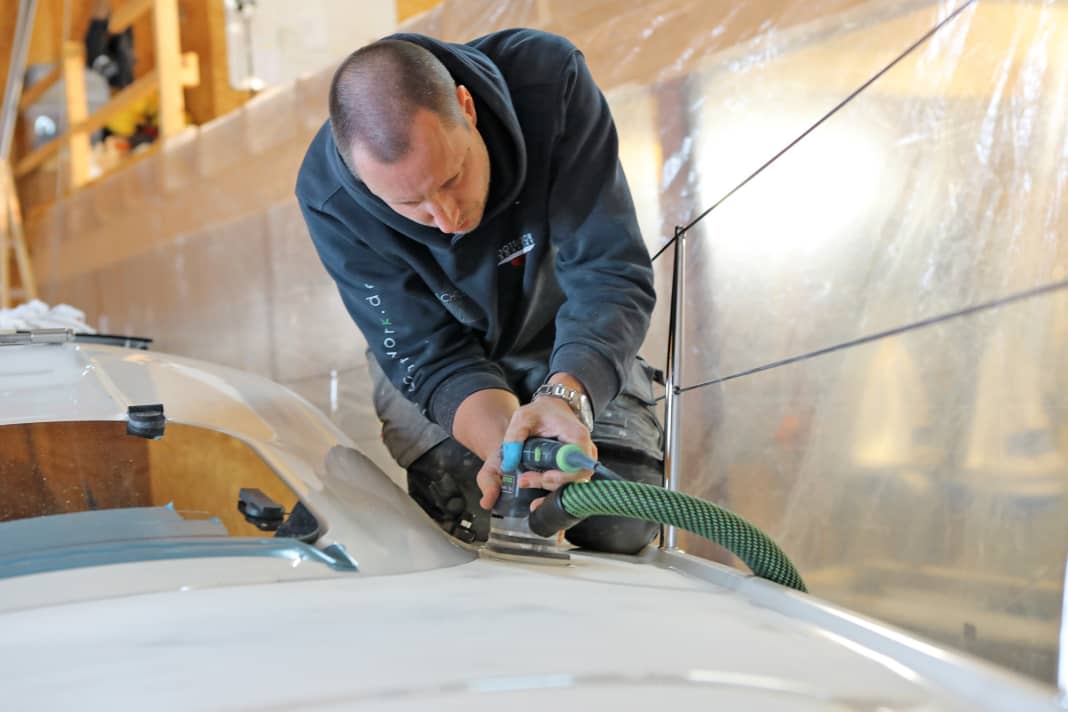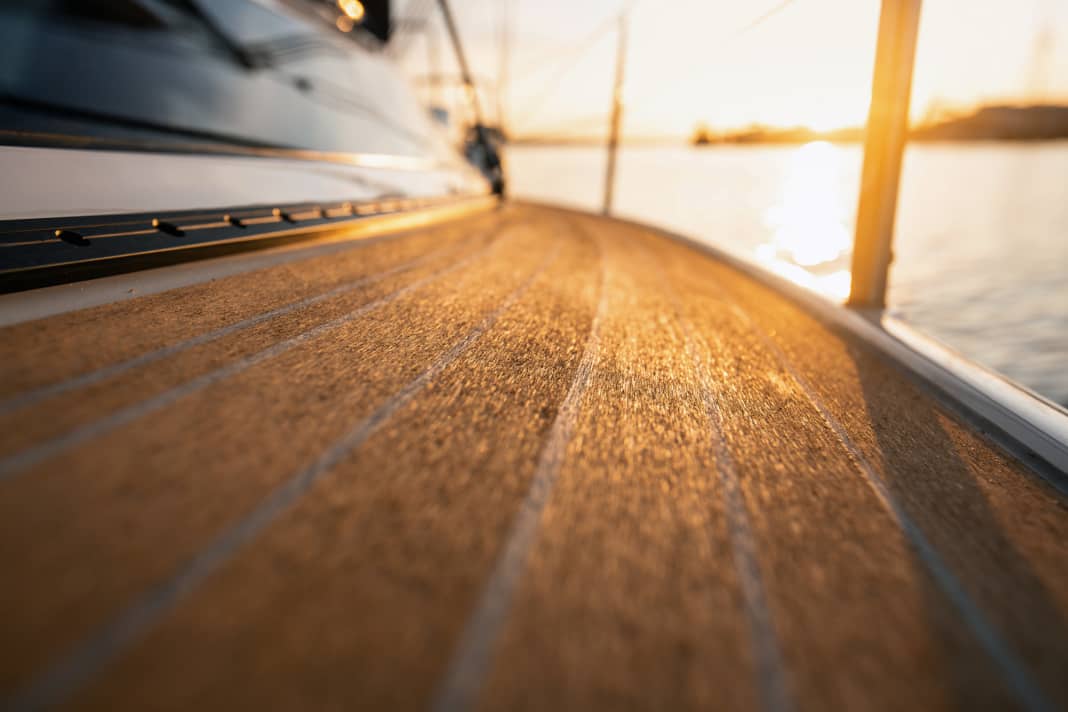





Due to the accelerated deforestation of the tropical rainforests in Myanmar, teak has fallen into disrepute for years. In addition, the import restrictions imposed by the European Union are now having an effect. As a result, the supply of this coveted decking material is likely to become very difficult; alternatives are therefore more in demand than ever.
In this article:
Alternative 1: Other types of wood
The most obvious choices are other woods. Iroko, also known as Kambala, or Oregon Pine are suitable in principle, but they do not offer the same properties as teak. With Iroko, there is a risk of micro-cracks. "The wood also has to be glued extremely carefully," says Michael Wolz from Wolz Nautic, Europe's largest supplier of prefabricated decks. "Iroko is prone to twisting and develops unimaginable torsional forces, especially with thin staves. The sticks then tear and lift off. This tendency is intensified by the colour of the wood: when wet, it is significantly darker than teak and heats up considerably in the sun," says Wolz.
Martina Georgus, head of the Bremen-based boat building wood and teak deck specialist Georgus, also confirms the problems: "With Iroko decks, the joint sealant often tears off." The expert therefore recommends Oregon pine as an alternative. The North American softwood has a long tradition, both as a working deck in commercial shipping and on Scandinavian classics.
However, it is not as weather-resistant as tropical woods, which is why it is usually oiled or varnished on yachts. The lower durability of Oregon Pine makes the wood unattractive from an economic point of view. "With a classically laid deck, the material only accounts for around 20 per cent," says Hauke Steckmest from Henningsen & Steckmest. Although Oregon Pine costs only around a third of teak at around 3,000 euros per cubic metre, the finished deck is hardly cheaper; Martina Georgus still reckons on a saving of around 20 percent compared to a teak deck.
Alternative 2: Modified woods
Modified woods such as kebony, for example, are at least partly of natural origin. This is radiata pine softwood that is impregnated with furfuryl alcohol and then tempered. The alcohol polymerises and permanently stabilises the cell walls, while at the same time the wood becomes hydrophobic, which is why it hardly rots and achieves the resistance class of teak. However, it also becomes hard and more difficult to bend. The contours of the staves following the deck contour are sometimes problematic.
In Germany, the Kurt Behn joinery from Hamburg has been offering prefabricated decks and poles made from kebony for ten years. "We have had good experiences with the durability of the wood," says Lorenz Behn. However, Kebony has not really been able to establish itself in yacht building.
Elan was the only series shipyard to include Kebony in its programme. According to Marketing Director David Rajapakse, however, the wood was only used on ten yachts, as the decks were badly worn and cracked. The Slovenian company now only offers PVC decking from Permateek as an alternative to teak.
Chemical modifications are promising, but capacities are lacking
The chemical modification of wood is generally considered to be very promising. Lignia, which is also based on radiata pine and is used by Spirit Yachts and others, is - or rather was - a suitable candidate for deck construction. The transformation from softwood to hardwood is achieved by impregnating the cell walls with special resin. Both visually and technically, Lignia comes close to teak. However, the manufacturer went bankrupt at the beginning of last year, shortly after the start of production. In the meantime, the plants have been bought up by competitor Accoya. However, the latter is focussing on architectural wood and has discontinued the production of Lignia.
"We have high hopes for Tesumo," says Michael Wolz. This is an FSC (Forest Stewardship Council for Sustainable Forest Management)-certified wood from Africa that is modified with a resin in a three-stage process. The process was developed at the University of Göttingen together with the Lürssen superyacht shipyard. According to Wolz, production is currently being expanded at the Bremen site: "We hope to be able to produce and deliver on a larger scale from the summer." Like all modified woods, Tesumo is not as easy to bend as teak, according to Wolz, but should be at least equivalent in other respects.
Overview of modified woods
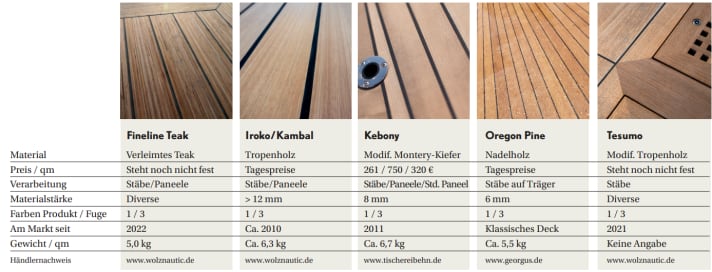
Alternative 3: Teak from other sources
If it is supposed to be real teak, there is still hope. The wood is also grown on plantations in Central America and Thailand. "It doesn't always have the desired quality for boat building. But if you can get by with stave lengths of up to two metres, there are also good woods that can be used in series production," says Wolz. As plantation teak has not really played a role in yacht building to date, the supply chains are still in development.
According to Wolz, the production of so-called fineline teak is also under construction. This is glued wood made from upright veneers. This means that even simpler - albeit FSC-certified - wood qualities can be processed into a durable product. In addition to the cost of teak, however, there is also the gluing. "This is only interesting for professional companies that can optimise the cutting with nesting technology so that hardly any waste is produced. Otherwise, the prices are higher than those of teak from Myanmar."
Alternative 4: Cork
Compared to wood, cork has an advantage in terms of sustainability. The tree is not felled to obtain the raw material, but the bark is peeled regularly, approximately every nine years. In purely mathematical terms, this even gives the deck a negative CO2 balance. However, the finished decking is not a purely natural product, but a composite of cork granulate and synthetic rubber.
The grain size of the granules and the proportion of binders vary depending on the supplier, which is also reflected in the different weights of the decking. However, the basic properties of the products are the same and are almost ideal as a deck covering. The high proportion of trapped air makes them light and heat-insulating. They do not heat up as much in the sun as artificial teak, have a sound-absorbing effect and feel pleasantly soft underfoot. The material is also non-slip and is considered durable.
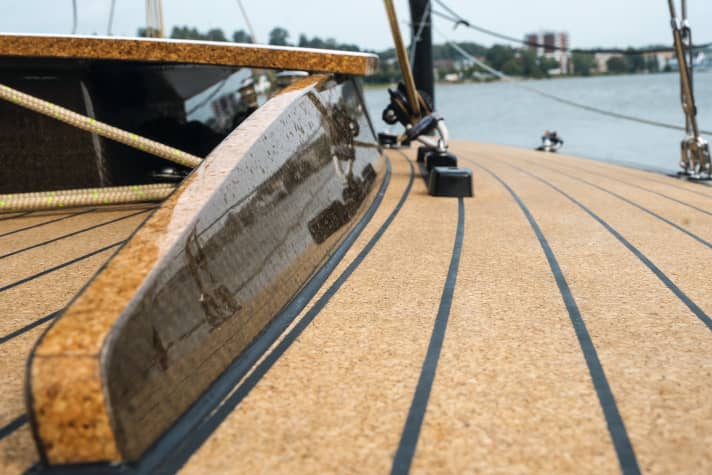
Cork look is a blessing and a curse
The typical appearance due to the grain and texture is both a blessing and a curse. On the one hand, the appearance of a cork deck is a matter of taste, but on the other, the material can be invisibly shafted and repaired. Cork is usually produced in Portugal, where it is pressed into panels. These are either cut into strips for traditional installation or glued to the deck as panels.
Depending on the manufacturer, the panels can also be milled with a customised joint design. Whether this is done using templates or the deck is digitally measured or scanned depends on the manufacturer. However, the material can also be processed and bonded by professionals themselves. Suppliers usually offer instructions for this or, as in the case of marine cork, even the hire of special tools. As a natural product, cork is only available in one colour per se. To prevent weather-related greying, the cork can be oiled or sealed with a PU coating, but this treatment is not technically necessary.
Another argument in favour of a cork deck is that it is comparatively easy to keep clean; dirt generally does not penetrate. A soft brush, water and, if necessary, a little washing-up liquid or mild detergent are suitable for cleaning a cork deck. Stubborn stains can be sanded out - and with the usual material thicknesses of 6 to 12 millimetres, this can be done several times. Cork has not yet played a role in series yacht building, only the Belgian Etap shipyard offered cork decks towards the end of its active period.
Overview cork decks
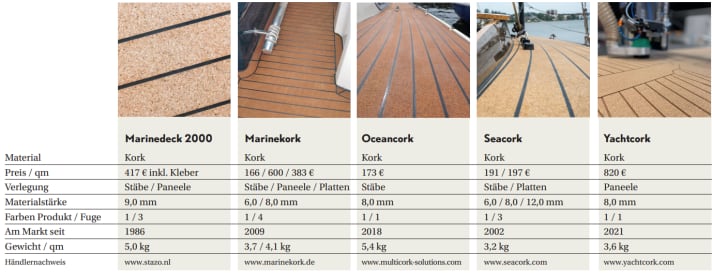
Alternative 5: Plastic replicas
If the flooring is primarily intended to be easy to maintain, wood imitations made of plastic are available. PVC-based products offer the most comprehensive selection. There are currently eight different deck coverings available in Germany alone. There are also coverings made of polyurethane and rolls.
One of the pioneers in the field of imitation teak is the Swedish company Flexiteek. Initially often ridiculed, PVC decking is now offered by many series-production yards such as X-Yachts, the Hanse Group and Sirius as the sole alternative to wood.
"We have been using Flexiteek for years. It enables very beautiful designs, is easy to work with, durable and extremely low-maintenance," says Andreas Unger from Hanse Yachts. Customers also appreciate the low maintenance requirements. Algae can hardly colonise the plastic surface and, if necessary, can be easily scrubbed off; in the case of extreme soiling, even the high-pressure cleaner can be used. "This leaves more time for sailing in the end," explains Unger. Added to this is the wood-like appearance.
Hardly distinguishable from real wood
With today's decking, it is often difficult to tell from the jetty whether it is real wood or a PVC substitute. Hauke Steckmest from Henningsen & Steckmest confirms this: "PVC decks are a good solution, especially when refitting plastic yachts. The teak deck is usually the only wood on these yachts. So why not choose a plastic deck covering as well? If you pay attention to a few details in the design and, for example, make mitre-cut reveals, the plastic often only betrays itself through the larger beam width," explains Steckmest.
Most PVC decks are manufactured in a similar way to a real wooden deck. The flexible planks come from a roll. They are joined with a type of tongue and groove and some are stapled with adhesive. The planks are then welded together in the joints from above and below using hot air to create a homogeneous, watertight panel. Depending on the layout, entire decks can be pre-produced in this way.
Welding requires experience, which is why manufacturers now all rely on a network of service companies to cut and weld the decking. In principle, you can install the panels yourself. To get the flexible decking smooth and clean on the deck, practice is helpful, which is why even professional shipyards sometimes call on the deck manufacturer's service centre for this step.
Only the Flexiteek offshoot Isiteek and Nuteak, imported by Yachticon, are designed for complete self-installation. Instead of thermal welding, a special adhesive is used for these products.
Overview of plastic rods
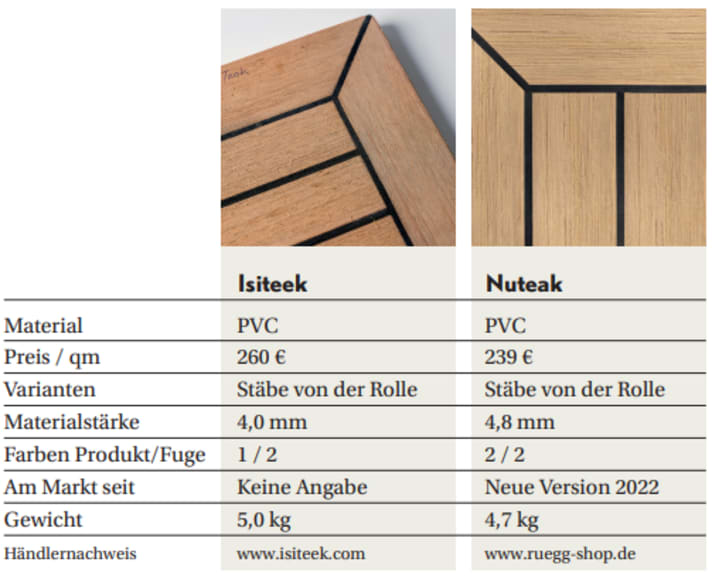
Milled panels offer plenty of design freedom
From a single mould: the latest development is milled panels. For the Ecodeck, Esthec, HM-Deck and High Level Floor (HLF) decks, no individual planks are welded together; instead, the panels and joint design are CNC-milled. This not only allows for any width of plank, but also unusual joint patterns and the use of other materials. While the High Level Floor developed together with the Fraunhofer Institute for Plastics Technology in Darmstadt is based on PVC, Ecodeck, Esthec and HM-Deck rely on polyurethane coatings. These coatings have been tried and tested for years in commercial shipping and are used as a substitute for wood on cruise ships, for example. Esthec is generally only used as a full-service product by shipyards or professionals, while the other products are also aimed at self-layers.
"HM-Deck is cast on a thin layer of GRP as a sheet material made from Sikafloor. The sheets are therefore completely homogeneous," says Markus Kalvelage from Hollweg-Marine. The diffusion-proof GRP backing also prevents the decking from expanding on the existing substrate. According to Kalvelage, the HM deck can be easily bonded without a vacuum process and is therefore well suited for do-it-yourself applications.
One problem that all plastic decks have to contend with is heating up in the sun. They heat up quickly, which makes walking barefoot uncomfortable or even impossible. To remedy this, most manufacturers have now increased the air content in the decking. This means that the material insulates better, gets less hot and cools down again more quickly.
To make the imitation wood look as authentic as possible, the plastic is roughly sanded, creating a fibrous surface. Finely graduated colour shades are also generally available. This allows the degree of weathering of the deck to be determined during construction between brand new and silver patina. Unlike wood and cork, the colour of plastic decking practically does not change over the years.
Overview of plastic panels

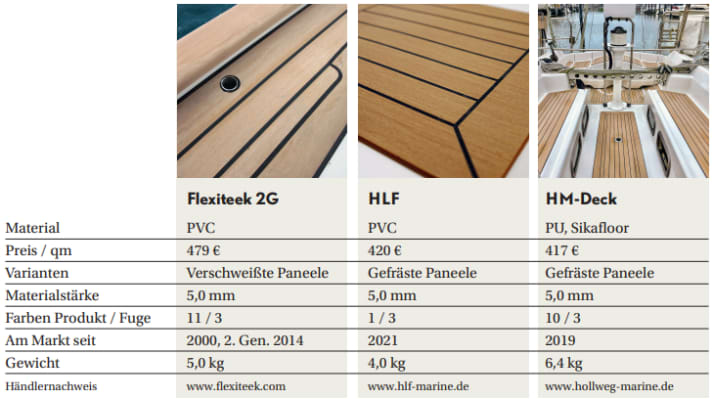

The cheapest alternative: roll goods
The classics Treadmaster and TBSafe have been on the market for decades. They do not offer a teak look and are usually laid as islands. Many products are now available in self-adhesive versions. However, according to Florian Steidle from importer Pfeiffer-Marine, the adhesive adheres so well and quickly, at least with TBSafe, that it is not possible to correct the fit of the patches. For larger pieces, he therefore recommends classic bonding with sealant.
We have not been able to contact the manufacturers and importers of the EVA foam covers Smartdeck and Seadeck, which were tested as very good in YACHT 6/21, so we have to assume that the products are no longer available on the German market. With Noskid, Vetus now offers a covering made of EVA foam.
Overview PVC from the roll
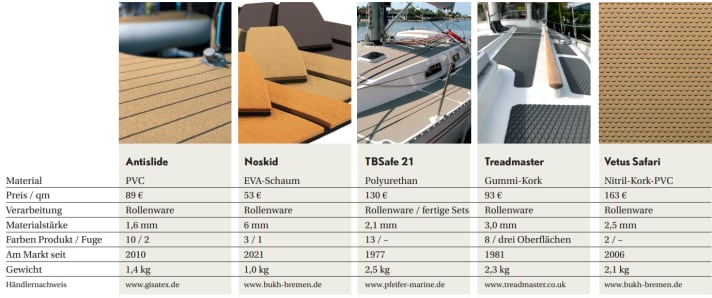
Laying artificial teak - this is how it's done
